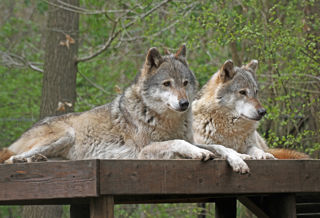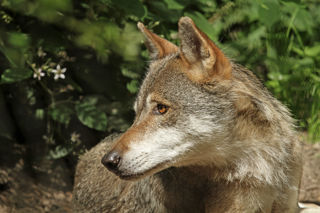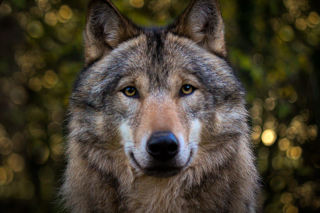
European Wolf
Canis lupus lupus
The Grey Wolf is the world's largest member of the dog family, varying in size and weighing from 30-60kg. All modern grey wolves are the same species, but there are many subspecies including the European Wolf. Wolves from Russia tend to be larger than animals in Western Europe, and the European wolves tend to be more sensitive and shyer than their American cousins.
They look like a large dog, with much longer legs, larger feet and head.
Their fur is very thick, made of two layers; a soft undercoat for insulation and coarse outer guard hairs. Colour can vary too, but generally grey with black, and brown flecks with lighter tummies.
Habitat
Highly adaptable, inhabit a variety of habitats, including deserts, urban areas, forests, grassland and mountainous regions. Wolf presence in a particular habitat depends greatly on prey numbers and human presence.
Behaviour
Very intelligent, social species. Each pack normally consists of a mated pair and their offspring. There is a strict hierarchy, enforced by the dominant pair through various vocal and visual behaviours.
Howling is an important part of wolf communication; calling pack members to a hunt, as an alarm, to locate pack members across large distances, and for pack bonding.
Hunts involve all pack members, chasing prey down until they are physically exhausted. Only the dominant pair will breed, having just one litter a year between April and May.
Threats
Hunting, particularly persecution to prevent livestock predation. Since 1970, legal protection for wolves in some parts of its range has led to a population bounce back. Continued threats are habitat loss and fragmentation; particularly the later which results in small populations without long term viability.

Distribution
Having once existed throughout Europe, it suffered a huge decline and become extinct through much of its European range since the middle ages. Recovery of European wolf populations started during the 1950s. Since then, natural recolonization and active reintroductions of wolves has seen numbers increasing and range gradually expanding. Currently European Wolves can be found in every European country except the UK.
Diet
Highly variable diet, ranging from large hoofed mammals (such as deer and elk), to smaller animals, carrion, rabbits, rodents, fish and berries.
UK Status
The last wolf in the UK died in Scotland in the 1700s.
Wildwood inside information
We are very proud of our wolf pack. Our dominant pair, Nuna and Odin, with their three male offspring, Minimus, Tiberius and Maximus, who were born at Wildwood in May 2018.
Family facts
Wolves are present in the myths and legends of most European cultures. Depicted often as a bad omen, symbol of danger, and witchcraft.
Wolves are on one of the most influential eco system engineers, creating habitats for an abundance of species.
The grey wolf’s closest living relative is the domestic dog, having diverged around 40,000-20,000 years ago when humans first started to domesticate those ancient wolves.




